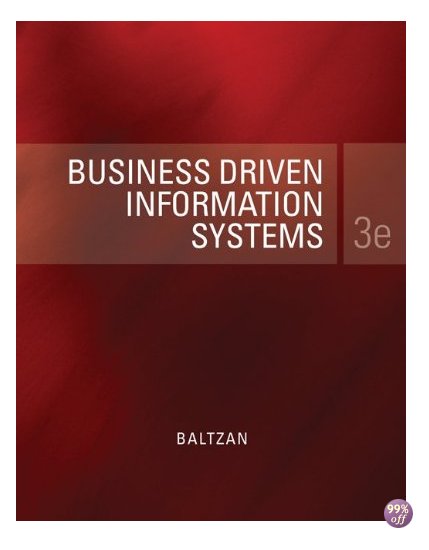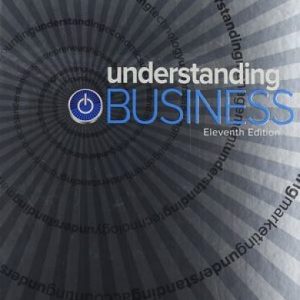This is completed downloadable of Solution Manual for Business Driven Information Systems 3rd Edition by Baltzan

Product Details:
- ISBN-10 : 0073376825
- ISBN-13 : 978-0073376820
- Author: Paige Baltzan
Business Driven Information Systems story: Business Driven Information Systems discusses various business initiatives first and how technology supports those initiatives second. The premise for this unique approach is that business initiatives should drive technology choices. Every discussion first addresses the business needs and then addresses the technology that supports those needs. This text provides the foundation that will enable students to achieve excellence in business, whether they major in operations management, manufacturing, sales, marketing, finance, human resources, accounting, or virtually any other business discipline. Business Driven Information Systems is designed to give students the ability to understand how information technology can be a point of strength for an organization.
Table of Content:
- PART 1 INFORMATION SYSTEMS ARE BUSINESS
- CHAPTER 1 BUSINESS INFORMATION SYSTEMS
- OPENING CASE STUDY Google: king of search (and therefore information)
- SECTION 1.1 // INFORMATION SYSTEMS IN BUSINESS
- Business in the information age
- Information technology versus information systems
- Data, information, business intelligence and knowledge
- Data
- Information
- Business intelligence
- Knowledge
- Common functional areas in an organisation
- A systems-thinking approach to information technology
- IT resources
- People: IT cultures
- People: roles and responsibilities in information technology
- The IS team
- The gap between business personnel and IT personnel
- Fundamental information systems in business
- Transaction processing systems
- Decision support systems
- Strategic support systems
- SECTION 1.2 // BUSINESS STRATEGY
- Identifying competitive advantages
- Porter’s Five Forces Model—evaluating industry attractiveness
- Buyer power
- Supplier power
- Threat of substitute products or services
- Threat of new entrants
- Rivalry among existing competitors
- Using the Five Forces Model to analyse the airline industry
- Porter’s three generic strategies—choosing a business focus
- Value chain analysis—executing business strategies
- Value creation
- Global IT
- Business in the global environment
- CLOSING CASE STUDIES
- Closing Case Study 1.1: e-Exam trial at CQU
- Closing Case Study 1.2: Apple—complications made simple
- Critical business thinking
- Apply your knowledge
- CHAPTER 2 A BRAVE NEW CONNECTED WORLD
- OPENING CASE STUDY Disruptive technologies shape the world
- SECTION 2.1 // OUR CONNECTED WORLD
- The Web changed the world
- The Internet changed business
- Benefits of a connected world
- Sharing resources
- Providing opportunities
- Reducing travel
- Challenges of a connected world
- Security
- Legal issues
- Social, ethical and political issues
- SECTION 2.2 // THE INTERNET AND THE WEB: A TECHNOLOGY REVOLUTION
- Disruptive and sustaining technologies
- Disruptive versus sustaining technology
- A Web evolution
- Web 1.0
- Web 2.0
- Content sharing through open sourcing
- User-generated content
- Collaboration inside the organisation
- Collaboration outside the organisation
- Networking communities with Web 2.0 technologies
- Web 2.0, social media and business
- Blogs
- Wikis
- Web 3.0
- The semantic Web
- The Internet of Things
- CLOSING CASE STUDIES
- Closing Case Study 2.1: Like us on Facebook! The rise of social business innovation
- Closing Case Study 2.2: Barcelona Smart City
- Critical business thinking
- Apply your knowledge
- CHAPTER 3 e-BUSINESS AND MOBILE BUSINESS
- OPENING CASE STUDY Paywalls and the business future of newspapers
- SECTION 3.1 // E-BUSINESS
- Advantages of e-business
- Expanding global reach
- Opening new markets
- Reducing costs
- Improving operations
- Improving effectiveness
- e-Business models
- Business-to-business (B2B)
- Business-to-consumer (B2C)
- Consumer-to-business (C2B)
- Consumer-to-consumer (C2C)
- e-Business forms and revenue-generating strategies
- Organisational strategies for e-business
- Marketing/sales
- Financial services
- Procurement
- Customer service
- Intermediaries
- e-Business tools used to connect and communicate
- Measuring e-business success
- Website metrics
- Web analytics
- e-Business challenges and benefits
- Protecting consumers
- Leveraging existing systems
- Increasing liability
- Providing security
- Adhering to taxation rules
- Trends in e-business: e-government and m-business
- e-Government
- SECTION 3.2 // MOBILITY: THE BUSINESS VALUE OF A WIRELESS WORLD
- m-Business: supporting ‘anywhere’ business
- Benefits of business mobility
- Enhances mobility
- Provides immediate data access
- Increases location and monitoring capability
- Improves workflow
- Provides mobile business opportunities
- Provides an alternative to wiring
- Challenges of business mobility
- Protecting against theft
- Protecting wireless connections
- CLOSING CASE STUDIES
- Closing Case Study 3.1: Grocery shopping online
- Closing Case Study 3.2: Shoes of Prey
- Critical business thinking
- Apply your knowledge
- CHAPTER 4 DECISIONS AND PROCESSES
- OPENING CASE STUDY Content streaming on demand
- SECTION 4.1 // DECISION-MAKING SYSTEMS
- Decision making
- The decision-making process
- Decision-making essentials
- Operational
- Managerial
- Strategic
- Metrics: measuring success
- Efficiency and effectiveness metrics
- The interrelationship between efficiency and effectiveness MIS metrics
- Benchmarking—baseline metrics
- Visualisation
- The future: artificial intelligence
- Expert systems
- Neural networks
- Genetic algorithms
- Intelligent agents
- Virtual reality
- SECTION 4.2 // BUSINESS PROCESSES
- Evaluating business processes
- Support: changing business processes with MIS
- Business process improvement
- Business process re-engineering
- Business process management
- Is BPM for business or IT?
- BPM risks and rewards
- Business process modelling
- The future: business process modelling and management
- CLOSING CASE STUDIES
- Closing Case Study 4.1: True confessions—of an airline revenue manager
- Closing Case Study 4.2: Using virtual reality to improve business decisions
- Critical business thinking
- Apply your knowledge
- PART 2 ESSENTIALS OF INFORMATION SYSTEMS
- CHAPTER 5 TECHNICAL FUNDAMENTALS
- OPENING CASE STUDY Supercell: concentrates on games not infrastructure
- SECTION 5.1 // HARDWARE AND SOFTWARE BASICS
- The business benefits of a solid MIS infrastructure
- Hardware basics
- Central processing unit
- Primary storage
- Secondary storage
- Input devices
- Output devices
- Communication devices
- Computer categories
- Software basics
- System software
- Application software
- SECTION 5.2 // COMMUNICATION NETWORKS
- Networks
- Network components
- Architecture
- Topology
- Protocols
- Media
- Network types
- Local area network (LAN)
- Wide area network (WAN)
- Metropolitan area network (MAN)
- Wireless networks
- Network transmission speeds
- Broadband connection types
- Network security
- Network providers
- Networks and mobile phones
- Addressing privacy concerns around RFID and LBS
- CLOSING CASE STUDIES
- Closing Case Study 5.1: Everything to do with IT changes all the time: keeping up after you graduate
- Closing Case Study 5.2: Advanced computing infrastructure may lower the price of your next cuppa
- Critical business thinking
- Apply your knowledge
- CHAPTER 6 SYSTEMS DEVELOPMENT AND PROJECT MANAGEMENT
- OPENING CASE STUDY Australia Post: staying relevant in the e-business era
- SECTION 6.1 // DEVELOPING ENTERPRISE APPLICATIONS
- Developing software
- The systems development life cycle
- Traditional software development methodology
- Waterfall methodology
- Agile software development methodologies
- Implementing agile methodologies
- Developing successful software
- Having unclear or missing business requirements
- Poor communication between management and the development team
- Inadequate project management
- Skipping SDLC phases
- Changing technology
- Catering for the cost of finding errors in the SDLC
- SECTION 6.2 // PROJECT MANAGEMENT
- Managing software development projects
- The triple constraint
- Project participants
- Choosing strategic projects
- Understanding project planning
- Project charter
- Project plan
- Managing projects
- Managing people
- Managing communications
- Managing change
- Outsourcing projects
- Outsourcing benefits
- Outsourcing challenges
- CLOSING CASE STUDIES
- Closing Case Study 6.1: Why do large government IT projects fail? HealthSMART project lets Victorian health services down
- Closing Case Study 6.2: myki: an integrated travel card for Victoria
- Critical business thinking
- Apply your knowledge
- CHAPTER 7 ENTERPRISE ARCHITECTURE AND SECURITY
- OPENING CASE STUDY Sony hack stops the world: well, Sony’s world
- SECTION 7.1 // ENTERPRISE ARCHITECTURE
- The business benefits of solid enterprise architecture
- Supporting operations: information architecture
- Backup and recovery
- Disaster recovery
- Business continuity planning
- Supporting change: infrastructure architecture
- Accessibility
- Availability
- Maintainability
- Portability
- Reliability
- Scalability
- Usability
- Supporting the environment: sustainable enterprise architecture
- Cluster computing
- Grid computing
- Cloud computing
- Virtualisation
- Making enterprise architecture green(er)
- Increased electronic waste
- Increased energy consumption
- Increased carbon emissions
- SECTION 7.2 // ENTERPRISE SECURITY
- Protecting intellectual assets
- The first line of defence: people
- The second line of defence: technology
- People: authentication and authorisation
- Data: prevention and resistance
- Attacks: detection and response
- Hackers and viruses
- Preventing viruses on a mobile device
- CLOSING CASE STUDIES
- Closing Case Study 7.1: Developing an enterprise-wide architecture within Insurance Australia Group
- Closing Case Study 7.2: Migration to Google docs: Bleeding Technology Pty Ltd
- Critical business thinking
- Apply your knowledge
- PART 3 ENTERPRISE INFORMATION SYSTEMS
- CHAPTER 8 QUALITY DATA AND BUSINESS INTELLIGENCE
- OPENING CASE STUDY Chupa Chups: how sweet it is
- SECTION 8.1 // DATA, INFORMATION AND DATABASES
- The business value of high-quality information
- Information type—transactional or analytical
- Information timeliness
- Information quality
- Information governance
- Storing data
- Storing data elements: entities and attributes
- Keys to data
- The business benefits of a relational database
- Increased flexibility
- Increased scalability and performance
- Reduced information redundancy
- Increased information integrity (quality)
- Increased information security
- Integrating information among multiple databases
- Integration tools
- The drawback of not integrating databases
- Data warehousing
- Multidimensional analysis
- Information cleansing or scrubbing
- SECTION 8.2 BUSINESS INTELLIGENCE (BI)
- Data mining
- Data mining tools
- Cluster analysis
- Statistical analysis
- Association detection
- Big data
- Relationship between data warehousing and data mining
- Business intelligence (BI)
- Business benefits of BI
- BI software/tools
- Data management tools
- Data discovery tools
- Reporting tools
- BI, business analytics and data science: similar but different
- CLOSING CASE STUDIES
- Closing Case Study 8.1: XBRL and business information supply chains: enhancing business-to-government reporting
- Closing Case Study 8.2: Data-driven innovation (DDI)—set to lead the way!
- Critical business thinking
- Apply your knowledge
- CHAPTER 9 ENTERPRISE INFORMATION SYSTEMS: ERP AND SCM
- OPENING CASE STUDY Still sick after $1.25 billion: Queensland Health ERP
- SECTION 9.1 // ENTERPRISE RESOURCE PLANNING (ERP)
- ERP fundamentals
- The evolution of ERP
- ERP components
- Core ERP components
- Extended ERP components
- e-Business
- Business intelligence (BI)
- Supply chain management (SCM)
- Customer relationship management (CRM)
- Integrating ERP
- ERP metrics
- Choosing ERP software
- Challenges of ERP
- The future of ERP
- SECTION 9.2 // SUPPLY CHAIN MANAGEMENT (SCM)
- Supply chain fundamentals
- Seven principles of SCM
- The benefits of SCM
- Improved visibility
- Improve collaboration
- Increased profitability
- SCM metrics
- The challenges of SCM
- The future of SCM
- Cloud computing and SCM
- CLOSING CASE STUDIES
- Closing Case Study 9.1: GoPro goes into the cloud
- Closing Case Study 9.2: ERP system takes ATE tankers to the next level
- Critical business thinking
- Apply your knowledge
- CHAPTER 10 ENTERPRISE INFORMATION SYSTEMS: CRM AND COLLABORATION SYSTEMS
- OPENING CASE STUDY Bosch—power from the people
- SECTION 10.1 // CUSTOMER RELATIONSHIP MANAGEMENT (CRM)
- CRM fundamentals
- Phases in CRM
- Types of CRM
- Operational CRM
- Analytical CRM
- Collaborative CRM
- The benefits of CRM
- CRM metrics
- The challenges of CRM
- The future of CRM
- SECTION 10.2 // COLLABORATION SYSTEMS AND TECHNOLOGIES
- What is collaboration?
- Collaborators
- Collaboration systems
- Knowledge management systems
- Content management systems
- Workflow management systems
- Groupware systems
- Collaboration technologies
- File storage and sharing
- Wikis
- Instant messaging
- Conferencing
- Social networking analysis
- CLOSING CASE STUDIES
- Closing Case Study 10.1: Creating enterprise resource planning (ERP) software beautifully
- Closing Case Study 10.2: CRM systems: giving customers that uncanny valley feeling
- Critical business thinking
- Apply your knowledge
- PART 4 BUSINESS AND TRANSFORMATION
- CHAPTER 11 ETHICS, PRIVACY, SOCIAL MEDIA AND FUTURE TRENDS
- OPENING CASE STUDY Bitcoin: a currency revolution?
- SECTION 11.1 // ETHICS AND PRIVACY
- Information ethics
- Information does not have ethics; people do
- Privacy in the information age: an overview
- Privacy in Australia
- Developing information management policies
- Ethical computer use policy
- Information privacy policy
- Acceptable use policy
- Internet use policy
- Email privacy policy
- Anti-spam policy
- Social media use in business
- Workplace monitoring policy
- Monitoring technologies
- Protecting privacy: handling personal information
- Privacy statements
- Third-party privacy programs
- Global information privacy issues
- Europe
- The United States
- Cloud computing and trans-border privacy considerations
- SECTION 11.2 // SOCIAL MEDIA
- Social media and today’s business
- Managing social media
- SECTION 11.3 // FUTURE TRENDS
- Reasons to watch trends
- Trends shaping the future of business
- The world’s population projected to be 9 billion by 2050
- People in developed countries are living longer
- Advances in communication technologies are changing the way we live and work
- The growth in information industries is creating a knowledge-dependent global society
- The global economy is becoming more integrated
- The economy and society are dominated by technology
- The pace of technological innovation is increasing
- Time is becoming one of the world’s most precious commodities
- CLOSING CASE STUDIES
- Closing Case Study 11.1: The Facebook experiment: legal—yes, but ethical?
- Closing Case Study 11.2: Privacy, copyright and online piracy of Dallas Buyers Club
- Critical business thinking
- Apply your knowledge
- PART 5 EXPAND YOUR KNOWLEDGE MODULES
- ABOUT THE MODULES
- GLOSSARY
- INDEX





